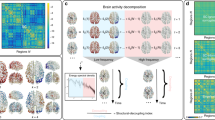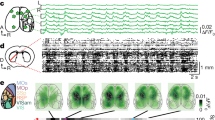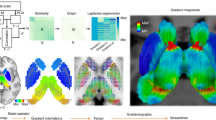Abstract
Anatomical tracing studies in non-human primates have suggested that corticostriatal connectivity is topographically organized: nearby locations in striatum are connected with nearby locations in cortex. The topographic organization of corticostriatal connectivity is thought to underpin many goal-directed behaviours, but these topographies have not been completely characterized in humans and their relationship to uniquely human behaviours remains to be fully determined. Instead, the dominant approach employs parcellations that cannot model the continuous nature of the topography, nor accommodate overlapping cortical projections in the striatum. Here we employ a different approach to studying human corticostriatal circuitry: we estimate smoothly varying and spatially overlapping ‘connection topographies’ from resting-state functional magnetic resonance imaging. These correspond exceptionally well with and extend the topographies predicted from primate tracing studies. We show that striatal topography is preserved in regions not previously known to have topographic connections with the striatum and that many goal-directed behaviours can be mapped precisely onto individual variations in the spatial layout of striatal connectivity.
This is a preview of subscription content, access via your institution
Access options
Access Nature and 54 other Nature Portfolio journals
Get Nature+, our best-value online-access subscription
$29.99 / 30 days
cancel any time
Subscribe to this journal
Receive 12 digital issues and online access to articles
$119.00 per year
only $9.92 per issue
Buy this article
- Purchase on Springer Link
- Instant access to full article PDF
Prices may be subject to local taxes which are calculated during checkout




Similar content being viewed by others
References
Haber, S. N., Fudge, J. L. & McFarland, N. R. Striatonigrostriatal pathways in primates form an ascending spiral from the shell to the dorsolateral striatum. J. Neurosci. 20, 2369–2382 (2000).
Haber, S. N. The primate basal ganglia: parallel and integrative networks. J. Chem. Neuroanat. 26, 317–330 (2003).
Alexander, G. E., DeLong, M. R. & Strick, P. L. Parallel organization of functionally segregated circuits linking basal ganglia and cortex. Annu. Rev. Neurosci. 9, 357–381 (1986).
Kemp, J. M. & Powell, T. P. S. Connexions of striatum and globus pallidus: synthesis and speculation. Phil. Trans. R. Soc. Lond. B 262, 441– 457 (1971).
Haber, S. N. & Knutson, B. The reward circuit: linking primate anatomy and human imaging. Neuropsychopharmacology 35, 4–26 (2010).
Samejima, K., Ueda, Y., Doya, K. & Kimura, M. Representation of action-specific reward values in the striatum. Science 310, 1337–1340 (2005).
Balleine, B. W., Delgado, M. R. & Hikosaka, O. The role of the dorsal striatum in reward and decision-making. J. Neurosci. 27, 8161–8165 (2007).
Maclean, P. D. Cerebral evolution and emotional processes: new findings on striatal complex. Ann. NY Acad. Sci. 193, 137– 149 (1972).
Takikawa, Y., Kawagoe, R. & Hikosaka, O. Reward-dependent spatial selectivity of anticipatory activity in monkey caudate neurons. J. Neurophysiol. 87, 508–515 (2002).
Haber, S. N., Kim, K.-S., Mailly, P. & Calzavara, R. Reward-related cortical inputs define a large striatal region in primates that interface with associative cortical connections, providing a substrate for incentive-based learning. J. Neurosci. 26, 8368–8376 (2006).
Haber, S. N. Corticostriatal circuitry. Dialogues Clin. Neurosci. 18, 7–21 (2016).
Faraone, S. et al. Attention deficit/hyperactivity disorder. Nat. Rev. Dis. Primers 1, 15020 (2015).
Goodman, W. K. et al. Deep brain stimulation for intractable obsessive compulsive disorder: pilot study using a blinded, staggered-onset design. Biol. Psychiatry 67, 535–542 (2010).
Cilia, R. et al. Pathological gambling in patients with Parkinson’s disease is associated with fronto-striatal disconnection: a path modeling analysis. Mov. Disord. 26, 225–233 (2011).
Selemon, L. D. & Goldmanrakic, P. S. Longitudinal topography and interdigitation of corticostriatal projections in the rhesus monkey. J. Neurosci. 5, 776–794 (1985).
Jarbo, K. & Verstynen, T. D. Converging structural and functional connectivity of orbitofrontal, dorsolateral prefrontal, and posterior parietal cortex in the human striatum. J. Neurosci. 35, 3865–3878 (2015).
Fudge, J. L. & Haber, S. N. Defining the caudal ventral striatum in primates: cellular and histochemical features. J. Neurosci. 22, 10078–10082 (2002).
Draganski, B. et al. Evidence for segregated and integrative connectivity patterns in the human basal ganglia. J. Neurosci. 28, 7143–7152 (2008).
Yeterian, E. H. & Van Hoesen, G. W. Cortico-striate projections in rhesus monkey: organization of certain cortico-caudate connections. Brain Res. 139, 43–63 (1978).
Averbeck, B. B., Lehman, J., Jacobson, M. & Haber, S. N. Estimates of projection overlap and zones of convergence within frontal-striatal circuits. J. Neurosci. 34, 9497–9505 (2014).
Thivierge, J.-P. & Marcus, G. F. The topographic brain: from neural connectivity to cognition. Trends Neurosci. 30, 251–259 (2007).
Jbabdi, S., Sotiropoulos, S. N. & Behrens, T. E. The topographic connectome. Curr. Opin. Neurobiol. 23, 207–215 (2013).
Leh, S. E., Ptito, A., Chakravarty, M. M. & Strafella, A. P. Fronto-striatal connections in the human brain: a probabilistic diffusion tractography study. Neurosci. Lett. 419, 113–118 (2007).
Cohen, M. X., Schoene-Bake, J.-C., Elger, C. E. & Weber, B. Connectivity-based segregation of the human striatum predicts personality characteristics. Nat. Neurosci. 12, 32–34 (2009).
Verstynen, T. D., Badre, D., Jarbo, K. & Schneider, W. Microstructural organizational patterns in the human corticostriatal system. J. Neurophysiol. 107, 2984–2995 (2012).
Di Martino, A. et al. Functional connectivity of human striatum: a resting state fMRI study. Cereb. Cortex 18, 2735–2747 (2008).
Choi, E. Y., Yeo, B. T. T. & Buckner, R. L. The organization of the human striatum estimated by intrinsic functional connectivity. J. Neurophysiol. 108, 2242–2263 (2012).
Pauli, W. M., O’Reilly, R. C., Yarkoni, T. & Wager, T. D. Regional specialization within the human striatum for diverse psychological functions. Proc. Natl Acad. Sci. USA 113, 1907–1912 (2016).
Haak, K., Marquand, A. & Beckmann, C. Connectopic mapping with resting-state fMRI. Neuroimage https://doi.org/10.1016/j.neuroimage.2017.06.075 (2017).
Navarro Schröder, T., Haak, K. V., Zaragoza Jimenez, N. I., Beckmann, C. F. & Doeller, C. F. Functional topography of the human entorhinal cortex. eLife 4, e06738 (2015).
Van Essen, D. C. et al. The WU-Minn human connectome project: an overview. Neuroimage 80, 62–79 (2013).
Belkin, M. & Niyogi, P. Laplacian eigenmaps and spectral techniques for embedding and clustering. Adv. Neural. Inf. Process. Syst. 14, 664–668 (2002).
Gelfand, A ., Diggle, P., Fuentes, M & Guttorp, P. Handbook of Spatial Statistics (CRC, 2010).
Barch, D. M. et al. Function in the human connectome: task-fMRI and individual differences in behavior. Neuroimage 80, 169–189 (2013).
Smith, R., Keramatian, K. & Christoff, K. Localizing the rostrolateral prefrontal cortex at the individual level. Neuroimage 36, 1387–1396 (2007).
Craddock, R. C., James, G. A., Holtzheimer, P. E. III, Hu, X. P. & Mayberg, H. S. A whole brain fMRI atlas generated via spatially constrained spectral clustering. Hum. Brain Mapp. 33, 1914–1928 (2012).
Kelly, C. et al. l-Dopa modulates functional connectivity in striatal cognitive and motor networks: a double-blind placebo-controlled study. J. Neurosci. 29, 7364–7378 (2009).
Hariri, A. R. et al. Preference for immediate over delayed rewards is associated with magnitude of ventral striatal activity. J. Neurosci. 26, 13213–13217 (2006).
Partiot, A. et al. Delayed response tasks in basal ganglia lesions in man: further evidence for a striato-frontal cooperation in behavioural adaptation. Neuropsychologia 34, 709–721 (1996).
Buckner, R. L., Andrews-Hanna, J. R. & Schacter, D. L. The brain’s default network: anatomy, function, and relevance to disease. Ann. NY Acad. Sci. 1124, 1–38 (2008).
Tomasi, D. et al. Dopamine transporters in striatum correlate with deactivation in the default mode network during visuospatial attention. PLoS ONE 4, e6102 (2009).
Weissman, D. H., Roberts, K. C., Visscher, K. M. & Woldorff, M. G. The neural bases of momentary lapses in attention. Nat. Neurosci. 9, 971–978 (2006).
Van Hoesen, G. W., Yeterian, E. H. & Lavizzo-Mourey, R. Widespread corticostriate projections from temporal cortex of the rhesus monkey. J. Comp. Neurol. 199, 205–219 (1981).
Yeterian, E. H. & Pandya, D. N. Corticostriatal connections of the superior temporal region in rhesus monkeys. J. Comp. Neurol. 399, 384–402 (1998).
Badgaiyan, R. D. Dopamine is released in the striatum during human emotional processing. Neuroreport 21, 1172–1176 (2010).
Smith, S. M. et al. Network modelling methods for fMRI. Neuroimage 54, 875–891 (2011).
Glasser, M. F. et al. The minimal preprocessing pipelines for the Human Connectome Project. Neuroimage 80, 105–124 (2013).
Smith, S. M. et al. A positive–negative mode of population covariation links brain connectivity, demographics and behavior. Nat. Neurosci. 18, 1565–1567 (2015).
Salimi-Khorshidi, G. et al. Automatic denoising of functional MRI data: combining independent component analysis and hierarchical fusion of classifiers. Neuroimage 90, 449–468 (2014).
Bishop, C. Pattern Recognition and Machine Learning (Springer, 2006).
Kraha, A., Turner, H., Nimon, K., Zientek, L. R. & Henson, R. K. Tools to support interpreting multiple regression in the face of multicollinearity. Front. Psychol. 3, 44 (2012).
Haufe, S. et al. On the interpretation of weight vectors of linear models in multivariate neuroimaging. Neuroimage 87, 96–110 (2014).
Winkler, A. M., Webster, M. A., Vidaurre, D., Nichols, T. E. & Smith, S. M. Multi-level block permutation. Neuroimage 123, 253–268 (2015).
Efron, B., Tibshirani, R., Storey, J. D. & Tusher, V. Empirical Bayes analysis of a microarray experiment. J. Am. Stat. Assoc. 96, 1151–1160 (2001).
Acknowledgements
We acknowledge support from The Netherlands Organization for Scientific Research (NWO) by VIDI grants to A.F.M. (grant no. 016.156.415) and C.F.B. (864.12.003), a VENI grant to K.V.H. (016.171.068) and under the Gravitation Programme (024.001.006 supporting A.F.M.). We also acknowledge funding from the Wellcome Trust UK Strategic Award (098369/Z/12/Z). The funders had no role in study design, data collection and analysis, decision to publish, or preparation of the manuscript.
Author information
Authors and Affiliations
Contributions
A.F.M., K.V.H. and C.F.B. devised the experiments, A.F.M. and K.V.H. analysed the data and all authors wrote the manuscript.
Corresponding author
Ethics declarations
Competing interests
C.F.B. is director of and shareholder in SBGNeuro Ltd. The other authors declare no competing interests.
Supplementary information
Supplementary Materials
Supplementary Methods, Supplementary Figures 1–5, Supplementary References
Rights and permissions
About this article
Cite this article
Marquand, A., Haak, K. & Beckmann, C. Functional corticostriatal connection topographies predict goal-directed behaviour in humans. Nat Hum Behav 1, 0146 (2017). https://doi.org/10.1038/s41562-017-0146
Received:
Accepted:
Published:
DOI: https://doi.org/10.1038/s41562-017-0146
This article is cited by
-
Gradients of Brain Organization: Smooth Sailing from Methods Development to User Community
Neuroinformatics (2024)
-
Functional gradients of the medial parietal cortex in a healthy cohort with family history of sporadic Alzheimer’s disease
Alzheimer's Research & Therapy (2023)
-
Gradients of striatal function in antipsychotic-free first-episode psychosis and schizotypy
Translational Psychiatry (2023)
-
A phylogenetically-conserved axis of thalamocortical connectivity in the human brain
Nature Communications (2023)
-
Correspondence of functional connectivity gradients across human isocortex, cerebellum, and hippocampus
Communications Biology (2023)



